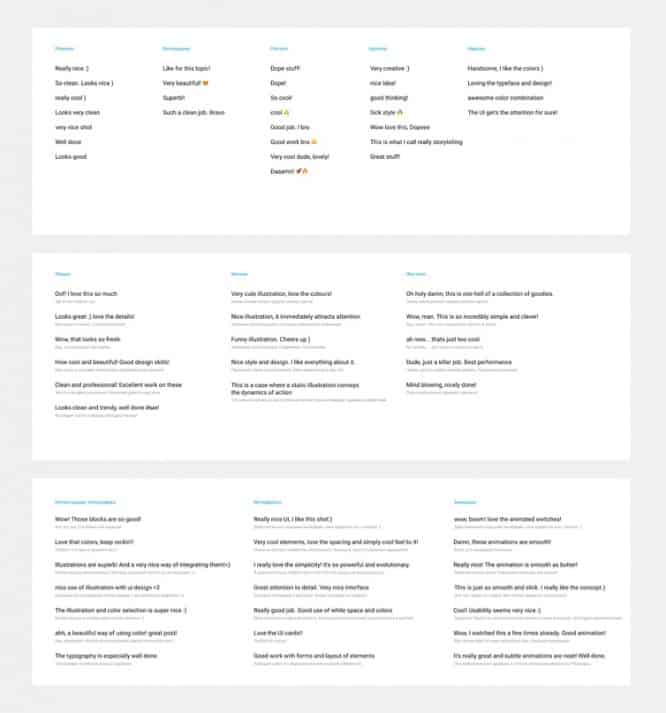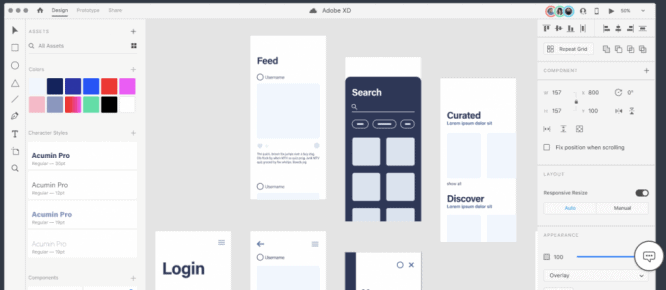Dribbble by the numbers
Dribbble by the numbers
The design community has already said a lot about dribble and how you can upgrade your account. But all articles are limited to the usual thesis, with no facts or statistics to check. I wondered if these theses work and how you can upgrade your account from scratch.
I fully agree with the opinion that you need to download skills, not an account. But I decided to approach this question a little pragmatic. Not good / bad, but see what I can get out of it. In this article, I will try to answer the following questions:
- How to get followers and likes?
- Does activity (comments, likes) influence account promotion?
- How long does it take to receive the first order?
I will make a reservation right away that my “experiment” lasted only a month and I do not have a complete statistical picture. But even according to the following indicators, certain conclusions can be drawn.
Now thesis and to the point
I decided to create an account on dribbble from scratch, without strong visual skills and without winding up likes and followers. Pursued the following goals:
- Improve your UI skills
- Check the main thesis: likes and followers are the result of good work or a pumped up account and subscriber base
- Check the strength of a number of other theses, which I wrote about above
What I definitely didn’t do was follow other people (only in response to a subscription). But not because he is an evil and disgusting person. This will keep the experiment clean and eliminate other factors. At the end of the month, I wanted to see how many subscribers will turn out and how they correlate with likes.
For this month, I set a goal to achieve an even number on the following indicators:
- 10 shots (the first 3 had to be deleted, so it turned out 7)
- 300 comments (but not just comments like “awesome”, but more humane ones related to the post itself)
- 500 likes (considered regular likes + likes of shots to which I left a comment)
- Half of all works are Rebound (reworking shots of other designers)
All these indicators are easy to track, since they have a numerical equivalent and you do not need a pro-account for this (yes, there are extended statistics, but come on, so not interesting).
results
For each post, I kept statistics on the main parameters and tracked their change over time. I also continued to leave comments and likes in order to compare these two groups of data later. At the end of the month, we got the following picture:

Each card has the following indicators:
- Sequence of posts
- Number of subscribers at the time of publication (in a pink circle)
- Day and time of publication
- The work itself
- Statistics for the first hour (since the publication of this shot)
- Statistics for the first day (since the publication of this shot)
- Statistics at the moment 02/01/2020 (in parentheses to likes it showed how many likes were put by users, on whose work I left a comment)
findings
Publication time
You can make a conclusion by the time of publication based on viewing the shot in the first hour. Since I do not have a large subscriber base, and the small part that is, most likely will not see it in the first hour. Therefore, views will only be from those users who have met my post in the feed. In addition, each post was posted on a different day and time.
So what we see. The number of views is in the range of 63–80 in the first hour. There is an opinion that it is better to post the post on Tuesday and Friday 16: 00-19: 00 Moscow time. Looking at the metrics, I didn’t see much difference in posting times. Why is that?
Perhaps at this time there is really a lot of traffic of users who view the feed. But the number of published works is also increasing. These two metrics cancel each other out and we don’t get much of a boost in views.
Quality of work
Half of my work is rebound on shots of other users. I tried to take only interfaces, because they are not as difficult to repeat as illustrations or graphs. design. At the same time, he did not deviate much from the concept and execution. I think I did it more or less. But the indicators of my work are not even close to the indicators of the sources.
One could argue that the source code has better worked out details, they fell into the context and style of the time when they were made. But there are no global differences between the works.
There are examples of shots from other designers, very decent level, but who also have few likes. Hence the conclusion that a good job ≠ a lot of likes.
How to get to the top
If we look at the best works for a week or a month, we will see plus or minus the same teams. Mostly teams, not individual designers.
Be that as it may, getting into these collections is very difficult. They are rightfully occupied by cool designers and strong teams (studios).
How many subscribers came from comments
As I said earlier, I left 300 comments under the work of other designers. Eventually eighteen of them subscribed to my account (this is 6% of the total number of comments). It would seem that not such a large figure. But now I have only 41 subscribers and it turns out that 43% of these is the result of the comments I have left. Already a nicer figure)
A reasonable question arises. Is it worth the time spent? Yes, if you automate this process. At the very beginning, I compiled a file with ready-made comments by category, size and “mood”. Then he threw all of them into the cart and, depending on the shot, copied and pasted one or another comment. I left 10 pieces a day. This process took about 15 minutes…

How many likes did you get from subscribers
As a result of all posts, I got 238 likes, 52 of them were left by users to whom I left a comment (this is about 22%). I think this is a very good indicator to start with.
Who are these subscribers
I also wondered who was following me. Since I am an interface designer, it is not difficult to assume that designers from this direction will subscribe to me.
In most cases this is the case, but there are exceptions. About 27% percent of subscribers are designers from completely different fields: branding, 3D, illustrators. From this we can conclude that it is not necessary to comment only on shots with interfaces and the web.
Conclusion
In the end, I would like to write a couple of thoughts about this site, the “experiment” itself and plans for the future. But first, I will outline a few theses that I learned during this time:
- A good shot does not guarantee a rapid increase in subscribers and likes
- Social interaction really helps in promoting your account.
- In the beginning, most of your subscribers are inactive and do not greatly affect the promotion of your account or specific work.
- You can’t become popular by working only on a subscriber base
- This platform really pumps up visual skills.
- You can only get to the top by being a great designer with strong work.
Source: Design Kabak
…


